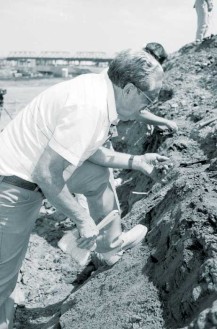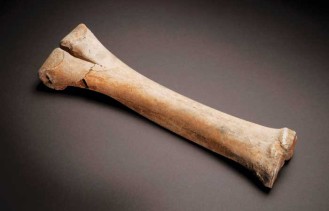
Denver Museum of Nature & Science volunteer John Shinton excavating a Cretaceous dinosaur rib fragment from Coors Field. Image: R. Wicker, DMNS Archives
Last summer my kids wanted to go hiking along our local creek. About halfway down the trail, this usually turns into “Papa, carry me.” But not this time.
While walking down the embankment, we spotted something chalky weathering out of the bluff. Sporting jagged edges and a half-dozen pointy teeth—it was a fossil jaw from some ancient creature. Despite its decayed appearance, the kids thought it was as cool as Katy Perry.
Excited by their discovery, they metamorphosed into trailside detectives. Each bend was scoured for something new. My job was to ID each item they discovered. Mostly there were dozens of ‘very fossil-like’ sticks and stones, plus a few ‘dinosaur-egg-shaped’ river cobbles. Ever optimistic, my kids still recite the tale of the trailside fossil as a prelude to our hikes. Even when we’re hiking on granite.
Fossils are wonderfully abundant here in Colorado. Dino teeth, colossal clams, petrified logs—they’re all around us. Many are discovered by citizens just like you.
A neighbor told me about such a discovery—just up the street from here. In 2001, workers cleaning up the pits leftover from the Stapleton airport found some bones. They called the Denver Museum of Nature & Science. A team of staff and volunteers, including my neighbor, sprang into action to help unearth and conserve part of a fossilized camel leg. It is the best modern-style camel known from our state. Such extinct beasts roamed Colorado tens of thousands of years before humans did. Maybe this gnawed-up relic was buried sometime after serving as a drumstick.
A decade previously, dozer operators building Denver International Airport made an even more amazing discovery. While grading earth for the runways, they found giant fish tails entombed in rock. The Museum was called to the scene, but the fossils weren’t quite what they seemed. Rather than tails they were palm leaves! Felled by the thousands, they recorded a swamp where the airport was to be built. Like the fossil rainforest discovered during expansion of I-25 near Castle Rock, the DIA discovery provided scientists with new insights about what Colorado was like near the end of the age of dinosaurs.

Foot bone of a Pleistocene camel (Camelops sp.) collected near what is now Westerly Creek Elementary School. Image: R. Wicker, DMNS Archives
But what about dinosaurs, you might ask? Nary a scrap was found at these sites. Down in Littleton, though, an eagle-eyed dogwalker and his pup were about to hit the jackpot. Cruising through a housing development under construction, they traversed a site that had been scraped. Poking out from the dirt was more than Fido could unbury—a mongo bone. Partnering with the developer, scientists excavated teeth and more bones. Although only a partial skeleton was excavated, this was Colorado’s only Tyrannosaurus rex skeleton. The rest of this “T. rex with a street address” is still underground. Perhaps it’s peering upward at the bottom of the neighbor’s basement slab or awaits the installation of a new pool.
In 1993 crews began building the Rockies’ new stadium. Aft of home plate, they found some scrappy bits of bone. Although unquestionably dinosaur, the bones were completely unidentifiable. Such discoveries are usually ascribed to the most common dinosaur genus, Chunk-o-saurus. Jokes aside, the baseball bones were similar in size to the ribs of plant-eating dinosaurs like Triceratops—a beast common to Colorado, and one that was first discovered from a creek near Sports Authority Field. After the fossils were announced, fans became fossil-smitten, as did the Rockies. A year later they revealed their very own dino—a fuzzy Triceratops mascot named Dinger.
Although most fossil discoveries are of common or inconsequential creatures, game-changing specimens are occasionally found. And there are plenty of them underfoot here in Colorado. Collecting them requires a permit, unless on private land.
Think you’ve stumbled across something that’s rare or unusual? Give us a shout at the Museum. Record where it occurs, and email us a photo. We’ll get right on it.
In the meantime, think about fossils as carrots—if nothing else than to get yourself outdoors. Or get your kiddos to hike down the trail—on their own power, rather than yours.
James W. Hagadorn, Ph.D., is a scientist at the Denver Museum of Nature & Science. Suggestions & comments welcome at jwhagadorn@dmns.org



0 Comments